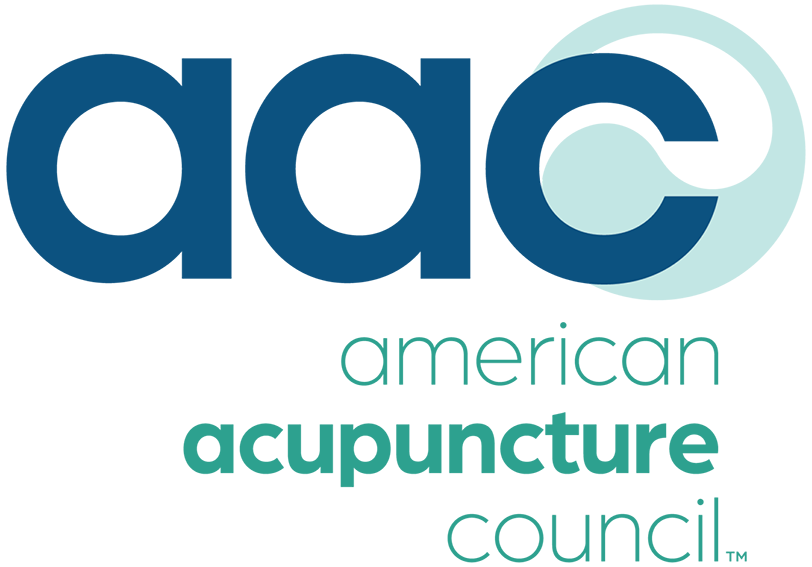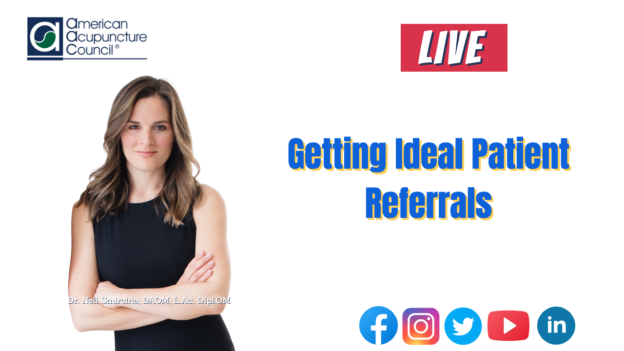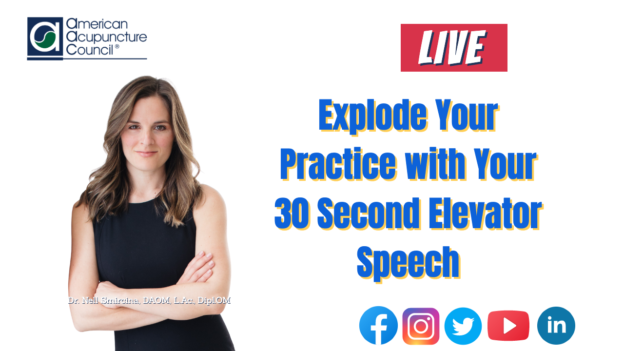“How do I Get Ideal Referrals into my Practice?”
Click here to download the transcript.
Disclaimer: The following is an actual transcript. We do our best to make sure the transcript is as accurate as possible, however, it may contain spelling or grammatical errors. Due to the unique language of acupuncture, there will be errors, so we suggest you watch the video while reading the transcript.
Hi everyone, and welcome. I’m so excited to be here. I’m Dr. Nell and I just wanna thank the American Acupuncture Council for the opportunity to be here and talk about one of the most common things that I get asked questions about, and that is, how do I Get Ideal Referrals into my Practice? Let. What are the slides?
So this is what we’re gonna be going over today. We have a lot of information we’re gonna get in a short period of time, so value packed. We’re gonna talk about those ideal patient referrals. Not just a Luke warm person who might be interested, but really, truly deep dive into how are we getting those ideal people into our practice?
We’re gonna go through what’s your current referral strategy. Three key questions that you really need to be asking before you even seek out referrals, and then what those next steps are. So let’s get right into it. What is your current referral strategy? And I will say a lot of times I get a blank stare when I ask practitioners this question.
Sometimes if it’s current patients, Oh, I rely on the patients who are already coming into my practice. They like my treatments, so of course they’re going to refer to me. Maybe it’s m. If you work in an integrative setting, if you are working with patients who have other health concerns other people on their care team, that could be MDs, that could be other integrative providers it could be maybe friends and family.
Are you thinking my friends and family know that I’m well educated in this medicine, They know that I can do to help so my friends and family can refer to me. That’s my strategy, That’s my plan. Maybe you enjoy public speaking. You might do continuing education. Perhaps you are a leader in a certain area of this medicine, and so other practitioners might see you as a thought leader, an expert in a certain space like fertility, for example, and then say, Oh, that’s the person who I’m gonna send referrals to.
I will say though, that when I ask this question, , it’s usually met with, I’m still looking for a strategy or I, I do rely on patients to refer to me, but I don’t really have a strategy around that. I don’t know how to ask people for referrals. And a lot of times we get stuck in this, what I call the.
The one man, one woman, one person referral machine. And that means that getting referrals into my practice is directly related to me being there personally. So I meet someone on the street and get them in or I am, at an event and I talk to someone and they become a patient. And really the goal of a referral strategy should be to get you out of a place where it has to be you telling people to come into your.
And there’s another trusted person funneling people in. And ideally, you want these to be ideal people for you. So that means people who geographically are in the right place, are the right fit for your practice. And we’re gonna go over some of those really key things and how do we make this a seamless transition.
So let’s go to the next one. First step. You’re gonna have three questions here, and the first thing you wanna ask yourself before embarking upon this journey to getting ideal referrals, who do I even want to attract into my practice? Let’s take a pause for a second because I know so many of you, including myself, wanna say anyone acupuncture can help.
So many things. Why would I turn anybody down? Why would I not seek out as many patients as. Having a targeted referral strategy does not mean that you have to turn down patients that walk in your door. It just means that you get really clear with what your ideal patient is so that your bandwidth, your energy, your time, your money.
All of it gets funneled to the right place to bring as many people in that are ideal for you and for your practice. We can’t be the be all, end all for everyone. But you wanna look at, okay, who am I attracting? Is it people with specific health issues? Do I like working in the fertility space?
I do a lot. Men’s health and post-surgical work specific health issues can be a great way to start narrowing down that target for you of who you wanna attract in if you have a specialty. Makes a lot of sense. But if you don’t, there are other ways to lean into that too. So you can look at age, location, obviously, financial status, occupational demographics.
Who is it going to be? Seamless and easy to get in and maybe past experiences with medicine. So I know that some practitioners. Are the person that people come to once they’ve exhausted a lot of other treatment options. They’ve tried particular things in western medicine, or they’ve gone for another type of care they need an additional provider on their care team or something didn’t work for them.
With my postsurgical patients, I have patients who have a history of addiction. And so when they’re having a surgery, they’re very concerned about avoiding pain medication after the surgery. And so that’s a real consideration. So someone is seeking me out because they know that they need that specialized care so that they don’t only have standard of care as their option.
Even looking at what interests do these particular people who you’re hoping to welcome into your practice as patients, what interests do they have? Do they travel a lot? Are they, really high performing, hardworking, stressed out individuals and their favorite downtime is to. Be a foodie and go to restaurants.
These are all things that you wanna consider when you’re looking at who is ideal. How do I come up with that ideal patient avatar? And we’re not gonna go into this a lot, but I wanna show you how granular this can truly get. So again, not reading all of this to you, but when you’re thinking of that ideal person who you wanna welcome in, you wanna name them, you wanna think about their age, What is their family life like?
What’s their occupation? Where are they living? Where are they traveling? What’s their personality type? Where do they go to eat? What do they wear? Where do they shop? Really thinking about what are their values, and that’s gonna bring us to this next very key question. So the first question was, who am I looking to attract into my practice?
Second question is, who does this person already value? Quick note here, not who we value as a practitioner, who does that person value? So we’ll go with my example of Craig who does Craig value? What’s important to him? And so when you’re thinking about who they value, you wanna think, All right, they already invest in this person.
And what I mean by invest we mean financially or with their time. They trust them. They rely on this person’s council, and they’re influenced by this person. So that’s how you can get a little bit of an idea about who they truly value. This person could be a personal trainer, it could be another healthcare provider that they have.
It could be the leader of their business, networking. Let’s go with personal trainers as an example. Let’s say Craig is religious about going to his personal trainer. And I’m speaking from experience here because I have done this and I know you all can do this very effectively. When I had was first starting out in Beverly Hills.
I had my practice and there was a. Equinox, I’m sure you all are very familiar with, and I started looking at the personal trainers there because all of those personal trainers had clients who were paying a very high amount for personal training. So I knew they were in close proximity to my office.
These clients, I knew that they could afford my services. I knew that they were already invested in their health and I knew they already trusted their. So when you get through that, you say, Oh, okay, so we’ll keep with the personal trainer example. I know that. So now that’s gonna lead us to our next question, and this is the big one.
Now how do I become the trusted source? And really the strong point behind that is, How can I provide value? We know you’re going to provide value for your patients, but it’s about getting them in the door. It’s about getting that buy-in. It’s about it not having to be you convincing that person to come in.
Following this example of Craig and the personal trainer, I want the personal trainer to start convincing people. To come in because then it’s not dependent on me to stumble upon Craig at a restaurant and convince him to get acupuncture. You have someone who is out there who believes in what you do, who can tell their clients, the people who value them, and their opinion that they should be coming to you.
And so when you’re thinking about how do you become the trusted. In this example for the personal trainer at Equinox thinking about how can you provide value, I always have loved to think that it’s enough to say. I can help your people. That’s true, but it’s not specific enough. And so when you’re looking for getting these ideal patients into your practice, you need to solve a specific problem for that personal trainer, for the person who has those ideal clients that you wanna bring into your practices.
So what could this look like for a personal trainer? What type of problems are they experiencing that you can solve? Perhaps if their clients are in pain, they’re not coming to train as often. Perhaps if they’re training athletes who want to get to a higher level of performance and be excited about continuing to train they wanna recover better, they wanna perform better, we need to be able to speak to those key areas where we can add value.
To that person who can influence their clients to then come into our practice as patients. So let’s just, That was a lot of information in a short period of time. Let’s look at it from big picture again. So when you’re looking for ideal patients to come into your practice, not just anybody, because you know you do well for your patients, people will refer to you, but this is about having that strategy that doesn’t take a lot of work.
That doesn’t require you being the person who always has to meet somebody for them to become a patient. You wanna ask these three key questions, and this is what is going to narrow. Focus, it’s going to allow you to use less bandwidth, less energy less money targeting people. So you’re gonna ask these three questions first, Who do I wanna attract?
Remember, get very specific with this. It doesn’t mean that these are the only people you are going to see in your practice. It simply means this is who I am going to put my energy towards. I’m gonna look for. Second question, who does this person value? And again, Not who we value, but who that ideal future patient values, who they invest in financially time-wise, rely on for their council.
So that’s really important cuz it’s that patient centered care. So we need to be thinking about what is this perspective patient care about. And then lastly, how do I become the trusted source? The trusted source? No, not only for the future patient, the trusted source for the person that future patient values.
So the personal trainer in this example, and that’s really about. How do you as a provider, as a business person, as an owner of a private practice, who wants to do right by your patients, how do you add value to that person’s life? How do you solve a problem for them? What is a specific thing that you can do that would make their job easier, that would make their life easier, that would help support their.
And I know you all, I know we come from a very genuine place with wanting to help patients with wanting to help people in general. So this is not a an unfamiliar area for us, right? We want to provide value that is very innate in this profession. So this is just an additional, more strategic step when it comes to referral.
How are you gonna add value to someone who has already the client base that you want to bring into your practice? And these are really the benefits of having a strategy, right? Because your skills, your time are so valuable if you are spending time and energy doing things. You didn’t go to school for, you’re not interested in, you’re spinning your wheels.
Just trying to make sure you have enough patience in your practice that you can help. That does a lot to your energy, and we don’t want that. We want to have more energy. We want to be really intentional with our energy, and it’s the same thing. You’re being intentional here with who you can add value to.
This also helps bring the right people to you. So once you identify these people, Sticking with that personal trainer example, they understand how your practice works. They understand the results that you can get for their clients. They understand the value that you bring to the table, and so you don’t have to reinvent the wheel every time explaining to someone, This is the way the process works, this, they’re gonna do a lot of that for you and make your job so much easier so you can focus on treating and getting great.
Which you can do. It also was time and energy saving, right? So again, it takes you out of that, Oh, I need to always be there to convince someone to come in. I need to be there to explain how acupuncture works and what it does. No, you train somebody else to do that, and then they’re doing that for you, and that effect multiplies, and that is so key.
So important and it’s very tangible, like you will get tangible results from this. And lastly, here are your next steps for these three key areas. You first and foremost, wanna identify your ideal patient. Being as specific as possible, knowing that being specific does not exclude anyone from coming in. It just means you’re gonna get the right people coming in for you and for your practice.
Determine who their trusted resources are, so the trusted resources. For your ideal patient, and then you just really importantly, need to think about that value add. How are you going to offer value to those trusted sources? I love talking through this with people. I’m happy to answer any comments moving forward and.
This is an exciting thing because we need more people who are familiar with our medicine. We are great practitioners. More people need to know about us, and this is a way to help people in your community send you the ideal people for your practice. So hope you all enjoyed that. I’m excited that I got to be here and talk through this proven strategy with you.
Please don’t miss another episode of To The Point. We next week are going to have Chen Yen, and I believe, I mean she, she is all about referrals as well, so she’ll be adding value for you next week. I hope you all enjoy it and I will see you next time on Two the Point.








